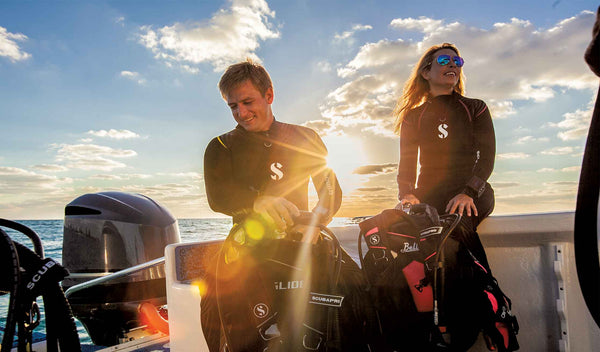
Why Your Dive Gear Needs a Specialized O-Ring Kit: A Guide to Air and Nitrox O-Rings
The Role of O-Rings in Scuba Diving

Did you know that O-Rings, despite being overlooked due to their small size, are vital in maintaining the efficiency and longevity of your scuba equipment?
These little nitrile or FKM / Viton rubber rings are essential components of many pieces of equipment used in scuba diving. O-rings are an essential component of your life support equipment when diving because they stop leaks at the attachment points of your scuba gear. O-rings are used in scuba regulators, underwater lights and strobes, dive computers and cylinder and tank valves.
The Difference Between Air and Nitrox O-Rings
Air Diving is generally composed of about 21% oxygen and 79% nitrogen while Nitrox Diving is a mixture of oxygen and nitrogen (typically in the range of 30-40% oxygen) , with oxygen content higher than in air.. The choice of gas greatly affects the selection of material used for these seals.
For Air Diving, standard o-rings, typically made from materials like nitrile (Buna-N) or Viton, are suitable for air diving. These materials are generally resistant to nitrogen and oxygen in the partial pressures found in air. For Nitrox Diving, because Nitrox contains a higher percentage of oxygen, especially at higher partial pressures, the o-rings must be more resistant to oxygen degradation. O-rings for Nitrox are often made from FKM or Viton rubber specifically designed to handle higher oxygen levels. Generally uses standard nitrile o-rings, Nitrox diving demands more specialized materials due to the higher oxygen content and its effects on o-ring durability. Choosing the right o-ring material and maintaining it properly are crucial for ensuring the safety and reliability of diving equipment.
What’s New in Our Ultimate O-Ring Kit

At Rosemont Scuba, we are dedicated to enhancing your diving experience not only through safety but also through convenience and efficiency. We’re excited to introduce the latest upgrades to our scuba kit, designed to make maintenance and emergency repairs easier and more effective. Here’s a look at the new features:
1. Two Brass Picks
Our kit now includes two high-quality brass picks. These tools are essential for handling delicate o-rings . The brass material ensures durability but it is soft enough to help prevent damage when carefully removing or installing o-rings.
- Detailed O-Ring Guide
Our detailed o-ring guide provides in-depth information on o-ring types, materials, and their specific applications. This guide is designed to help divers quickly identify and use the right o-rings for different components of their equipment.
- Clear PP Plastic Box
The new clear polypropylene (PP) plastic box is designed to keep your tools and components organized and protected. This durable and lightweight box provides a clear view of its contents, making it easy to find what you need quickly.
The new features of the Rosemont Scuba kit—the two brass picks, detailed o-ring guide, and clear PP plastic box—combine to create a more user-friendly and comprehensive product. These additions not only enhance the efficiency of routine maintenance and emergency repairs but also ensure that divers have everything they need for a safe and enjoyable diving experience.
How to Choose the Right Kit for Your Diving Needs
When selecting the right version of the Rosemont Scuba kit, it's essential to consider your diving habits and the type of gas you typically use. Each version is designed to meet specific needs based on the gas mixture used. Here’s a guide to help you make the best choice and tips on maintaining and replacing o-rings to ensure the longevity and reliability of your diving gear.
Air Diving
- Usage: Ideal for divers who use standard air (21% oxygen, 79% nitrogen) for recreational diving.
- Suitability: Perfect for those who dive in non-enriched air environments or who stick to typical recreational diving practices.
- Features: Equipped with components suitable for air’s lower oxygen concentration, ensuring compatibility and safety.
Nitrox Diving
- Usage: Designed for divers who use Nitrox (a gas mixture with higher oxygen content, such as EAN32 or EAN36) to extend bottom time and reduce nitrogen absorption.
- Suitability: Recommended for divers who participate in advanced or technical diving and use enriched air mixtures to manage their dive profiles.
- Features: Includes components optimized for higher oxygen concentrations, ensuring safety and effectiveness in enriched air environments.
O-rings must be properly maintained and maintained in order to last a long time and function as an effective waterproof seal. Below are some essential guidelines to stick to:
Routine Inspection: Check the O-rings for wear, damage, or degradation prior to every dive. Keep an eye out for any dryness, flattening, or cracks that can affect how well they seal. Before diving, replace the O-ring if you see any signs of wear.
Lubrication: To guarantee smooth functioning and avoid drying out, apply just a small amount of O-ring lubricant (please be sure not to use silicone grease when lubricating o-rings that will be used in more oxygen rich settings (for nitrox o-rings we recommend using christolube)..
Prevent Contaminants: Make sure O-rings are clean and clear of any impurities such as sand, dirt, salt, etc

Rosemont Scuba, is thrilled to introduce our newly enhanced O-ring Kit, designed to meet your specific diving needs with safety and reliability at the forefront. Whether you’re diving with standard air or enriched Nitrox, our newly improved kit is tailored to ensure your gear performs optimally and safely.
To help you stay informed and make the most of your diving adventures, we invite you to visit our website to explore our products, read our blogs, and stay informed about the latest in diving safety and maintenance. Explore the new Ultimate O-ring Kit and see how it can enhance your diving experience, whether you’re maintaining your current gear or preparing for new adventures!
